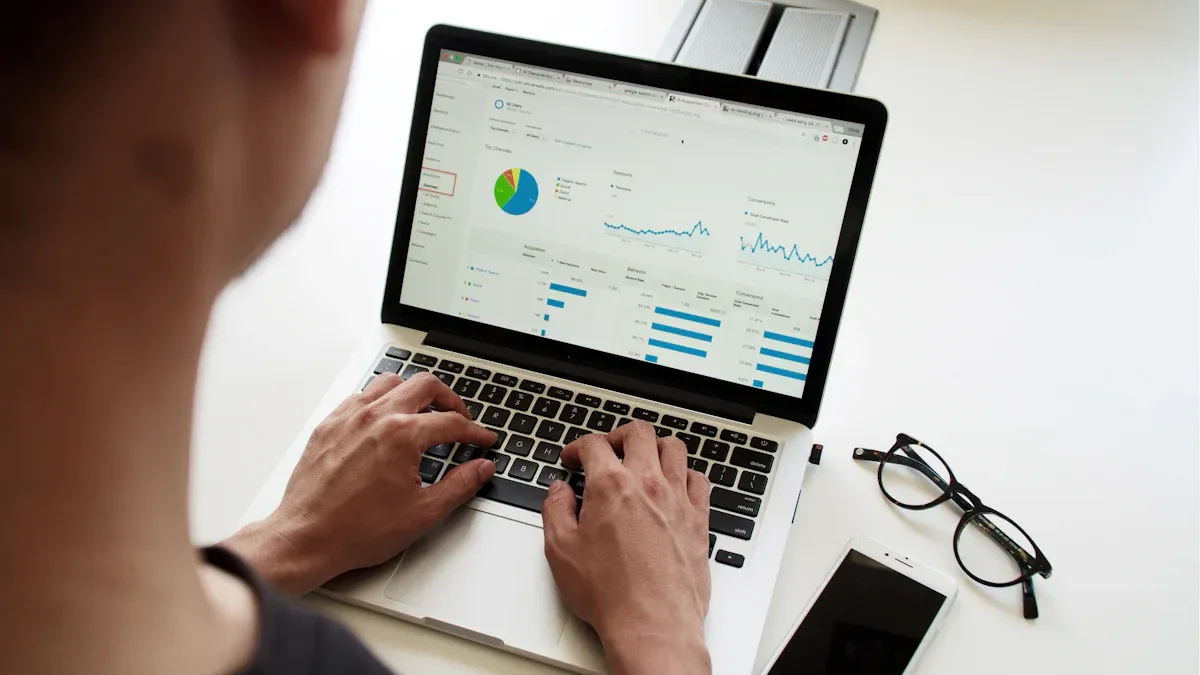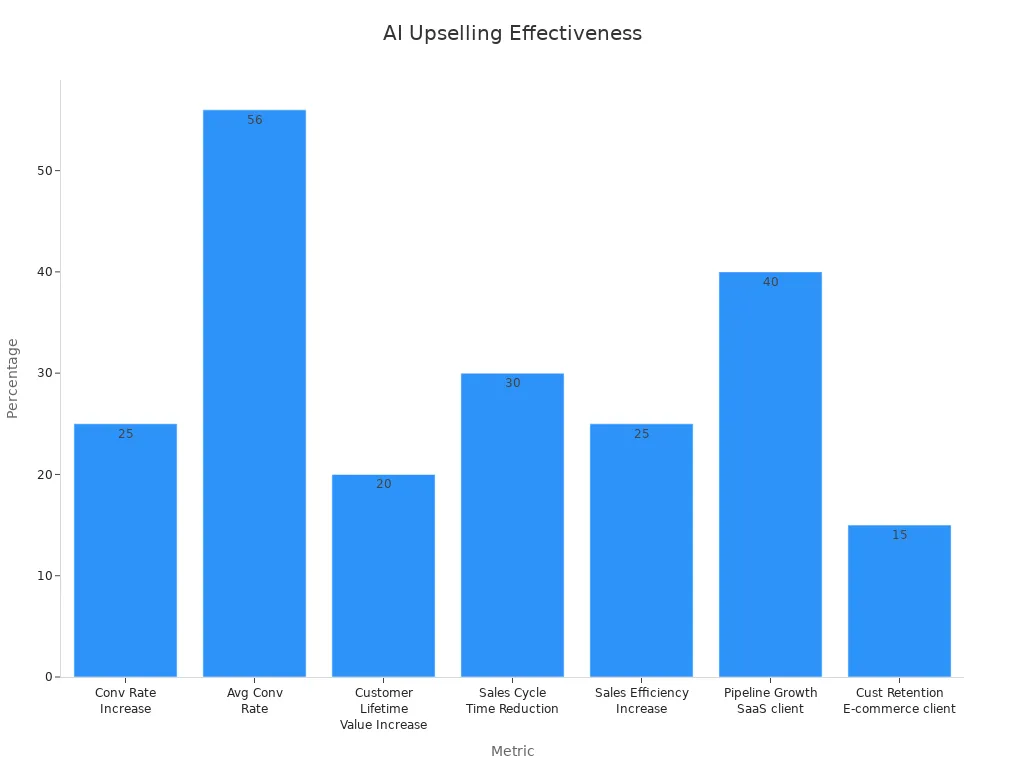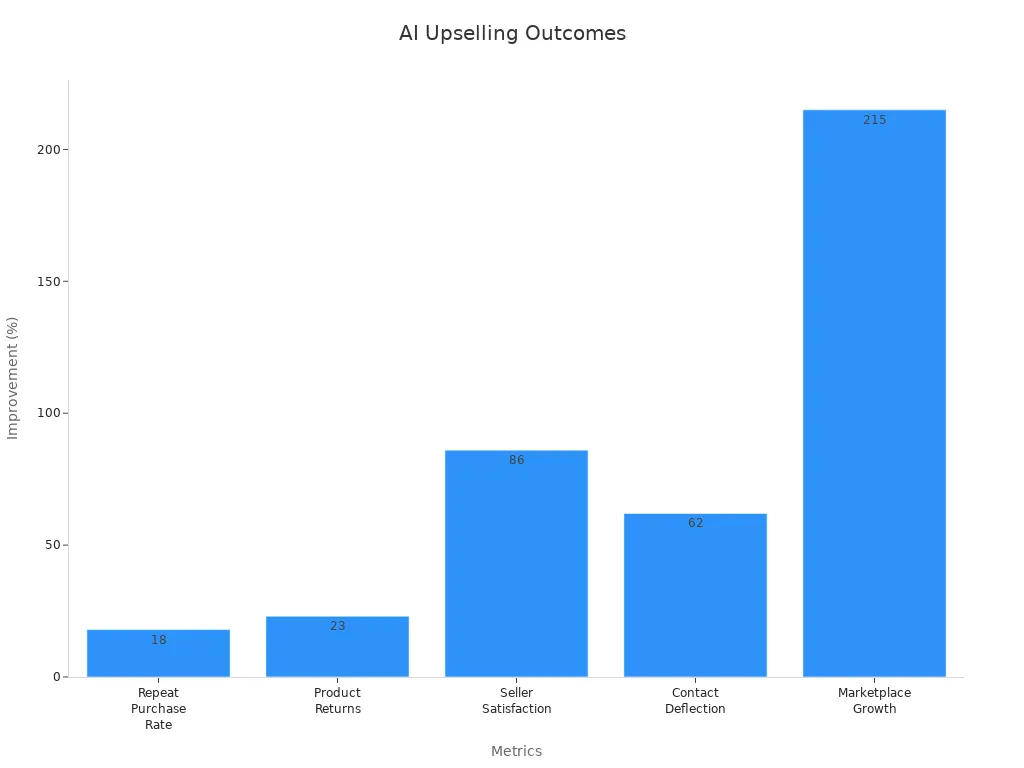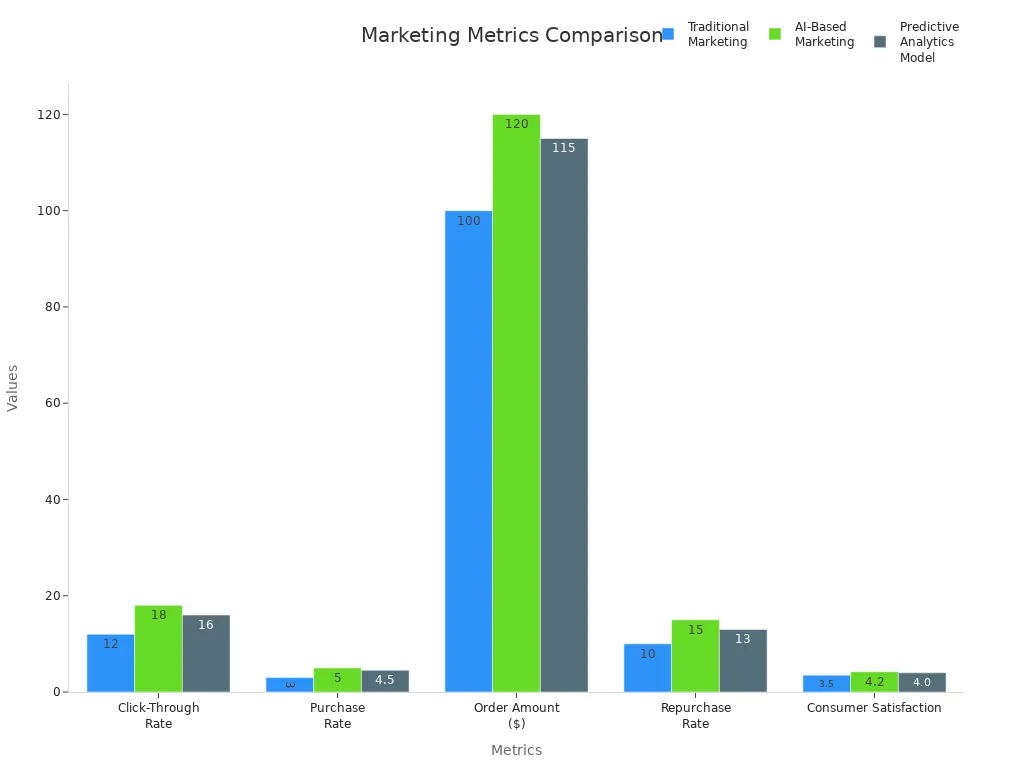Personalizing Upsell Content with AI Insights

AI-driven upselling is now the best way to sell. It works better than old sales methods. Companies using AI see big changes in important numbers:
Metric | AI-Driven Upselling / AI-Native Companies | Traditional / Non-AI-Native Companies |
|---|---|---|
Conversion Rate Increase | 25% increase (case study) | Baseline (traditional approach) |
Average Conversion Rate | 56% | 32% |
Customer Lifetime Value Increase | 20% increase | N/A |
Sales Cycle Time Reduction | 30% reduction | N/A |
Sales Efficiency Increase | 25% increase | N/A |
Pipeline Growth Increase (SaaS client) | 40% increase in 6 months | N/A |
Customer Retention Increase (E-commerce client) | 15% increase | N/A |

AI helps teams make Personalizing Upsell Content. This brings in more money, makes sales faster, and gives customers a better experience.
Key Takeaways
AI-powered upselling helps companies sell more things. It gives special product ideas using customer data and actions. Using AI tools like chatbots and predictive analytics makes customers happier. These tools make offers seem helpful and on time, not pushy. Making upsell content personal with AI brings more sales. It also builds stronger customer loyalty and speeds up sales in many fields. Companies must keep customer data safe. They should pick the best AI tools. They need to watch and improve their AI models often for good results. Starting with small AI projects and clear goals helps companies grow upselling over time.
AI-Powered Upselling

What It Means
AI-powered upselling uses smart technology to suggest products or services. These suggestions match what each customer might want. Companies use machine learning and data analysis to learn about customers. AI tools watch what people buy and what they like. They even notice when people like to shop. This helps businesses know when to offer the right product.
AI assistants, like TalkStack, talk to customers in a friendly way. They ask questions and give ideas that feel special to each person. Customers trust these chats because the AI listens and gives good advice. When AI connects with apps like WhatsApp, it is easy for customers to see offers. Customers do not feel forced to buy. They see the suggestions as helpful.
AI assistants use conversations to manage upselling.
They make offers personal by using customer history.
Connecting with messaging apps makes things easier.
Upsell ideas are gentle and useful, not pushy.
Customers feel like they are talking to a real person.
Core Value
The main value of AI-powered upselling is helping both businesses and customers. Companies get more repeat buyers and fewer returns. Sellers feel happier, and customer service works better. AI lets businesses grow without spending more money.
Metric | Outcome Description | Impact on Customer Outcomes |
|---|---|---|
Repeat Purchase Rate | Customers using AI support bought again 18% more often | Shows customers are happier and come back |
Product Returns | Visual AI help made product returns drop by 23% | Means customers get better help and keep products |
Seller Satisfaction | 86% of sellers said they were happy | Shows sellers get better support |
Contact Deflection | 62% of questions answered by AI, up from 17% before | Shows customer service is faster and easier |
Marketplace Growth | Number of sellers grew by 215% in 18 months, costs did not go up | Shows AI helps businesses grow without extra cost |

AI-powered upselling changes how sales work. Businesses give offers that fit the right time and person. Customers have a better and easier experience. This makes people want to come back and helps companies grow for a long time.
Personalizing Upsell Content
Data-Driven Insights
AI changes how Personalizing Upsell Content works. It takes customer data and finds useful patterns. Companies look at what people click, buy, and do online. They also check age, location, and what people say on social media. Polls and surveys give more details. Machine learning studies all this information to guess what customers want next.
Click-through rates, conversion rates, and AOV show if these ideas work.
Repeat purchases and CLV tell if customers keep coming back.
Teams use email open rates and time spent on content to improve.
Predictive analytics sorts customers, guesses demand, and sets prices.
Neural networks help make better suggestions and stop people from leaving carts.
AI models stay smart by learning from new feedback all the time.
Using AI for Personalizing Upsell Content brings real results. Predictive analytics helps companies sell more by knowing what people want and keeping enough stock. Hyper-personalization makes more people click and buy by looking at what they did before. Dynamic pricing changes prices fast to make more money. Teams can focus on top customers by using lifetime value. This makes marketing work better. Studies show that personalization can help sales grow by up to 40%.
Hyper-Personalization
Hyper-personalization makes Personalizing Upsell Content even better. AI uses old and new data to make special offers for each person. This is more than just simple suggestions. It sends the right message at the best time and place.
Dynamic emails are a good example. Amazon uses AI to send reminders and deals in emails. These emails change based on what people look at or buy. This helps more people finish shopping and buy extra things. Personalized emails get six times more sales than regular ones.
Special website experiences matter too. AI gives product ideas on websites, apps, and store kiosks. This helps people find new things to buy. Nike uses AI for email groups and app changes. This gave them a 25% higher click rate and doubled digital sales in three years. McDonald's uses AI for drive-thru menus. This makes people spend more and works in thousands of stores.
Company | AI Personalization Application | Numerical Outcome / Impact |
|---|---|---|
Nike | AI-driven email segmentation and app personalization | 25% higher click-through rate; digital sales doubled; improved retention |
McDonald's | AI-personalized drive-thru menus | Increased average order value; deployed to 12,000+ locations |
Amazon | AI product recommendations across channels | 35% of revenue from AI recommendations; higher basket size |
Starbucks | AI-driven loyalty program for offers | 30% increase in marketing ROI; 15% rise in engagement |
Industry-wide | General AI personalization benefits | 1.7× higher conversion rates; ~20% sales increase; 25% ROI increase |
Next best offer ideas use predictive analytics to pick the right products for each person. AI looks at search, browsing, and buying to help upsell and cross-sell. Real-time data keeps suggestions fresh and helpful. This makes people more interested and happy.
Tip: Companies should put all customer data together from every channel. This helps Personalizing Upsell Content work best. Watching sales lift, AOV, and repeat buys helps teams see what works and get better.
Using AI for Personalizing Upsell Content helps people stay loyal, buy more, and find new products. Real stories show 25% more repeat buys, 15% fewer abandoned carts, and 30% better campaign ROI. These results prove that AI-powered personalization is great for upselling today.
Benefits of AI Upselling
Revenue Growth
AI-powered upselling helps companies make more money in many fields. Companies use AI to spot the best times to upsell and find top customers. This way, they sell more and earn bigger profits.
SaaS companies saw revenue go up by 35% after using AI.
Retailers using AI saw their revenue rise by 19% on average.
AI product recommendation engines help raise revenue by 15-30%.
AI price optimization makes profit margins 10-15% better.
Businesses using AI in sales and marketing often see revenue go up by 10% or more.
AI lets teams spend less time on boring tasks by automating them. This gives sales teams more time to talk to important customers and close more deals. AI-powered marketing campaigns also help more people buy and increase the average order size.
Customer Experience
AI upselling makes the customer experience better by making each interaction feel special and on time. Companies using AI-driven CRM strategies see 15% more repeat sales and better customer retention. AI predictive analytics help companies know what customers want and when they might leave. This helps teams make special offers and keep customers happy.
Salesforce’s Einstein Analytics and Amazon Personalize both use AI to look at customer data and suggest the right products at the right time. These tools learn from every customer action, so their suggestions stay new and useful. Dynamic pricing and personal deals also make offers more interesting, so customers stay engaged and return.
Note: AI-powered customer journey mapping helps businesses give the best product suggestions and messages in real time, which makes customers more satisfied and loyal.
Conversion Rates
AI upselling helps companies get more sales by giving the right offer at the right time. Voice AI agents, like Dasha, talk to customers in real time and find upsell chances in a natural way. These agents help sales teams work better and get more sales by making each chat feel personal.
E-commerce case studies show that AI upselling, like targeted product suggestions, can boost conversion rates by 20-40%. Amazon’s recommendation engine is a good example. It looks at customer data and suggests products like "Frequently Bought Together," which makes people buy more and feel happier. AI models keep learning and getting better, so conversion rates keep going up over time.
How AI Works
Data Collection
AI starts by collecting lots of customer data. This data shows what people buy and what they like. It also shows how they look at things online. Companies get information from emails, social media, and chats with customer service. AI systems link with CRM platforms to keep all the data together.
Machine learning tools watch what customers do now and before.
AI-powered chatbots use natural language processing to understand questions.
Sentiment analysis tools check reviews and social posts to see feelings.
Automation does jobs like entering data and giving leads to the right person.
Tip: AI gets smarter with more data. This helps it make better offers for each customer.
Segmentation
After getting data, AI puts customers into groups. This is called segmentation. AI finds patterns in the data to group people who act the same. Segmentation lets companies send the best message to each group.
AI uses machine learning to sort by age, location, and shopping habits.
Predictive lead scoring shows who is most likely to buy.
AI changes groups as new data comes in.
Marketers can give each group special deals or content.
Segmentation helps marketing feel more personal. Companies can focus on their best customers and not send the same thing to everyone.
Predictive Analytics
Predictive analytics uses AI to guess what customers will do next. AI looks at what happened before and what is happening now. This helps companies plan and move quickly.
AI-driven predictive analytics helps marketers see trends and change plans fast. Automation does boring jobs like running campaigns and making reports. This saves time and stops mistakes. Teams can then do creative work while AI handles the data.
Metric | Traditional Marketing | AI-Based Marketing | Predictive Analytics Model |
|---|---|---|---|
Click-Through Rate | 18% (+6%) | 16% (+4%) | |
Purchase Rate | 3% | 5% (+2%) | 4.5% (+1.5%) |
Order Amount ($) | 100 | 120 (+20) | 115 (+15) |
Repurchase Rate | 10% | 15% (+5%) | 13% (+3%) |
Consumer Satisfaction (scale 1-5) | 3.5 | 4.2 (+0.7) | 4.0 (+0.5) |

Netflix uses AI to suggest shows and keeps users watching. This saves them almost $1 billion each year. Starbucks uses AI to send special offers and manage stock. This brings more sales and repeat visits. Mondelez uses generative AI to make ads faster and earn more money. Euroflorist used AI testing to get a 4.3% better conversion rate and 7% more online sales. They reached a 220% ROI.
Note: Predictive analytics helps companies plan ahead. It guesses what customers want and when the market will change. This means better timing and more sales.
Real-Time Recommendations
AI gives real-time recommendations by watching what customers do right now. This means customers see offers that fit their needs right away. AI connects with CRM systems and uses machine learning to keep ideas fresh.
AI checks what customers do on websites, apps, and in stores.
Chatbots and virtual assistants use natural language processing to help and suggest items.
Machine learning changes offers as new data comes in.
Automation lets teams send messages to many people at once.
AI-powered marketing automation makes product ideas better and keeps customers interested. Natural language processing helps chatbots talk in a friendly way. Predictive analytics helps companies send the right message at the right time. Hyperautomation mixes AI with robotic process automation to do hard marketing jobs. This saves time and cuts down on manual work.
Companies using real-time AI recommendations get more sales and happier customers. They also see more people come back. AI lets companies send personal messages to millions without losing quality.
Best Practices
Tool Selection
Picking the right AI tools is very important for upsell success. Teams should first decide what they want to achieve. This helps make sure AI tools fit business goals, like finding upsell chances. Top companies collect data from many places, like CRM systems and other platforms. They choose tools that work with both organized and messy data. It is important that tools work well with current systems, can grow, and are easy to use. People from different parts of the company should help early to make sure AI projects meet company needs.
Tip: Keeping track of where data comes from and how it changes helps everyone see and understand the AI process.
Data Quality
Good data is needed for strong AI-powered upselling. Teams must check and clean data by taking out repeats, making formats the same, and fixing mistakes. This stops AI from giving wrong or unfair results. Changing and joining data with normalization and feature engineering gets it ready for machine learning. Many companies use automation to make data prep faster and more steady. Checking and updating data often keeps AI models working well and up to date.
Data Quality Step | Purpose |
|---|---|
Remove duplicates | Prevent bias |
Normalize formats | Ensure consistency |
Correct errors | Improve reliability |
Feature engineering | Enhance model performance |
Continuous Optimization
AI models need care all the time. Teams should watch how models do and update them when new data comes in. Continuous optimization means checking results, retraining models, and making features better. Automation makes these updates happen faster. Companies that check and improve their data and models often get better upsell results. They also keep their AI working with new customer habits.
Customer Journey Alignment
Making AI upsell plans fit the customer journey gives a smooth experience. Teams look at each step of the journey and find the best times for upsell offers. AI tools can give personal suggestions at just the right time. This makes people more interested and helps more people buy. When companies match upsell content to what customers need and when they need it, trust grows and people come back to buy again.
Note: Using AI with data rules helps keep data safe and follow the law, which makes customers trust the company.
Overcoming Challenges
Avoiding Over-Personalization
AI can make upsell offers feel very personal. But if it gets too personal, customers might feel weird. Companies need to find a good balance. They should use AI to give helpful ideas, not make people feel watched. Teams can set rules for how much data AI uses. They can also try out different upsell messages to see what works best. When companies listen to what customers say, they learn what is good and what is not. This helps them stay helpful and not cross the line.
Tip: Companies should always let customers choose how their data is used and what kinds of offers they get.
Privacy and Security
Keeping customer data safe is very important in AI upselling. Companies need strong systems to protect information. They can do a few things to help keep data private and safe:
Start with small AI projects to test if they work and keep risks low.
Always think about what customers need and respect their privacy.
Make sure data is clean and right to stop security problems.
Tell customers how AI uses their data and follow the rules.
Pick AI tools that have good security.
Use AI that works with current systems to keep data safe.
Teams can also:
Teach workers about privacy rules.
Limit who can see customer data by using special controls.
Only collect data that is really needed.
Use safe data platforms with encryption and logs.
Put all customer data together to keep it safe and correct.
These steps help companies earn trust and keep customers safe.
System Integration
Adding AI to old systems can be tough. Many companies use lots of tools that do not always work together. Teams should pick AI that fits with what they already use. This makes sharing data and running things easier. Companies can ask IT experts to help plan how to add AI. They should test new AI tools in small ways before using them everywhere. When systems work well together, AI upselling works better and stays safe. This helps companies grow and keep control of their data and customer trust.
Measuring Success
Key Metrics
Companies need to know if AI-powered upselling is working. They watch numbers that show if things are getting better. These numbers help leaders see the whole picture. Teams check money, how work gets done, and if customers are happy. They also look at how fast choices are made and if new ideas are growing.
KPI Category | Key Metrics / Examples | Measurement Methods / Validation Techniques |
|---|---|---|
Financial Metrics | Revenue uplift (conversion rate %, incremental sales revenue, average revenue per user/customer) | A/B testing, pre-post comparisons, control groups, pilot studies to isolate AI impact |
Operational Metrics | Error/defect rates, process time, throughput, productivity, uptime | Baseline measurement, time and motion studies, process mining, system telemetry analysis |
Customer Experience Metrics | CSAT scores, Net Promoter Score (NPS), churn rate %, average response time, first-contact resolution | Customer surveys, behavior tracking, user experience monitoring, before-after comparisons |
Decision Quality Metrics | Decision cycle time, forecast error reduction, schedule adherence | Measuring decision speed improvements, outcome quality, downstream effects like inventory levels |
Innovation & Growth Metrics | Number of new products/features, market share changes, patent filings | Competitive analysis, market share tracking, qualitative linkage to AI-driven innovation |
Measurement Methodologies | Establish baselines, use control groups or A/B tests, continuous monitoring, benchmarking | Scientific measurement approaches to ensure accurate attribution and quantify delta improvements |
Companies that use many types of metrics do better. PwC found that tracking both money and work numbers helps companies reach their goals 2.5 times more often.
ROI Tracking
Tracking ROI helps companies see if AI upselling is worth it. Teams compare sales and costs before and after using AI. They use A/B tests and control groups to check if AI made the change. Watching results over time shows if things keep getting better.
Boston Consulting Group says AI helps launch products 30% faster. Forrester says companies using AI for customer experience get 3.5 more points in market share in two years. Accenture says AI-powered customer service can make people 20% happier and lower costs.
Tip: Teams should set clear starting points and check often. Using process mining, time studies, and feedback gives a full view of ROI. This helps leaders make smart choices and keep making upsell plans better.
Real-World Examples

E-Commerce Case
E-commerce companies use AI to help sell more and keep customers. Koçtaş is a big store that uses AI text analytics to check what customers say. Their system looks at over 10 million sales every year. Real-time sentiment monitoring lets them find problems fast. When Koçtaş saw stock and pickup issues, they fixed them right away. This kept sales strong and made customers happier. Shoppers felt listened to and stayed loyal.
Amazon uses AI for upselling too. Their recommendation engine shows products based on what people look at and buy. This makes up 35% of Amazon’s total sales. Customers see things they want, so they buy more each time. Personalized offers make shopping simple and fun.
Companies using AI in e-commerce have fewer abandoned carts and more repeat buyers. Customers trust brands that meet their needs.
SaaS Case
Software-as-a-Service companies use AI to keep customers happy and coming back. Sharekhan, a financial company, uses an AI-powered feedback engine. This tool made first response times 70% faster. Their Net Promoter Score (NPS) went up by 30 points. Fast replies helped fix problems before they got bigger. Because of this, Sharekhan kept more customers and got a better name.
A metals supplier in manufacturing uses AI for marketplace management. The company got more sales conversions and made fewer product mistakes. Buyers could find products more easily, which made things simpler and made customers happier.
Company / Sector | AI Application | Numerical Evidence | Qualitative Evidence |
|---|---|---|---|
Koçtaş (Retail) | AI text analytics on customer feedback | 10M+ transactions analyzed yearly; real-time sentiment monitoring | Improved omnichannel experience; enhanced loyalty |
Sharekhan (Financial Services) | AI-powered feedback engine | 70% faster response; +30 NPS | Immediate client support; better retention |
Metals Supplier (Manufacturing) | AI marketplace management | Higher sales conversions; fewer errors | Easier product search; less customer effort |
Eureko Insurance (Insurance) | Real-time CX measurement | Faster issue response; lower churn | Company-wide focus on customer needs |
AI-powered upselling helps many kinds of companies. They get more sales, better loyalty, and stronger customer engagement.
Implementation Guide
Assess Readiness
Businesses need to see if they are ready for AI upselling. They should follow some easy steps: 1. Check if their data is clean and organized. This means looking at what customers do and say. Good data helps AI work better. 2. Make sure their systems can use new AI tools. They should see if their systems can grow and connect with others. 3. Set rules for using AI the right way. This includes privacy and following the law. 4. Build a team that knows about AI. They can teach current workers or hire new people. 5. Start with small projects, like chatbots or simple upsell helpers. Small wins help leaders support the plan.
Tip: Companies should look for early signs that customers might leave. They can use predictive analytics to find good times to upsell.
Build and Train
After checking if they are ready, teams need to build and train their AI. They should do these things: - Collect customer data from websites, apps, and chats. - Use sentiment analysis to learn how customers feel when they get help. - Train AI with real customer data so it learns what works. - Test the AI with simple jobs, like suggesting products or answering questions. - Make sure the AI can grow as the business gets bigger.
A good technical setup helps AI run smoothly. Teams should keep learning and getting better at using AI.
Launch and Monitor
When the AI is ready, companies can start using it and watch how it does: - Track important numbers like ROI, customer happiness, and how many problems AI solves. - See how often people still need help from humans. - Use QA tools to check if the AI is working right and find mistakes. - Update the numbers often to keep up with changes in what customers want and new AI tools.
Watching the AI all the time helps teams find ways to make it better. Regular updates make sure the AI keeps helping the business reach its goals.
Do’s and Don’ts
Best Practices Table
AI-powered upselling works best when companies use smart strategies and avoid mistakes. Teams that care about customers and act honestly get better results and stronger bonds. These best practices help companies get the most from AI upsell content:
Make each upsell offer fit what the customer wants. When suggestions feel personal, people trust you and come back.
Look at things like what customers bought, what pages they saw, and how happy they are. This helps find the best time to upsell.
Show upsell offers at important times, like when someone checks out or calls for help. Good timing makes people say yes more often.
Give only three to five upsell choices. Use simple groups like “Good, Better, Best.” This makes it easy for customers to pick.
Give rewards like discounts, bundles, or free gifts. Make sure these deals still let you make money.
Teach workers to upsell in a fair way. They should know what customers need and always be honest.
Try out different upsell messages and track how they do. Keep making changes to get more people to buy.
Use tools like CRM, marketing software, and dashboards. These help make upsells personal and show what works.
Always follow the rules and act fairly. This keeps your brand safe and makes customers trust you.
Don’t give too many choices, raise prices too fast, make false claims, or offer upsells at bad times.
Tip: Companies that put customers first and act honestly keep loyal buyers and do better than others.
Do’s | Don’ts |
|---|---|
Personalize offers | Overwhelm with too many choices |
Use customer data and insights | Make misleading or exaggerated claims |
Time offers for key engagement | Present upsells at the wrong moment |
Limit options and show comparisons | Raise prices beyond acceptable thresholds |
Incentivize with value | Ignore customer feedback |
Train staff on ethics | Neglect compliance and transparency |
Test and optimize regularly | Rely on outdated or generic strategies |
Using AI for Personalizing Upsell Content helps companies in many ways. Teams get more sales, bigger orders, and happier customers. Companies use predictive analytics, real-time recommendations, and customer segmentation to make upsells better.
Important numbers are conversion rates, average order value, and upsell conversion rates.
Amazon’s special offers help them make more money.
Checking these numbers often helps teams get better.
Begin with small steps, see what works, and grow those ideas for long-term success.
FAQ
What is AI-powered upselling?
AI-powered upselling uses smart computer programs to suggest products or services for each customer. These programs look at what people buy and what they like. Companies use this technology to sell more and make customers happier.
How does AI personalize upsell offers?
AI gathers data from what customers do, like buying things or visiting websites. It uses machine learning to guess what someone might want next. This helps companies send the best offer at the right time.
Is customer data safe with AI upselling tools?
Most companies use strong security to keep customer data safe. They follow privacy rules and use encryption. Customers can often pick how their data is used. Companies must protect information and earn trust.
Can small businesses use AI for upselling?
Small businesses can use AI tools made for them. Many platforms are easy to set up and not too expensive. These tools help small teams make smart offers and compete with bigger companies.
See Also
Achieving SEO Excellence Using Perplexity AI Techniques
Writesonic AI And QuickCreator Battle For Content Supremacy
Customizing Startup Blog Content To Engage Target Readers

